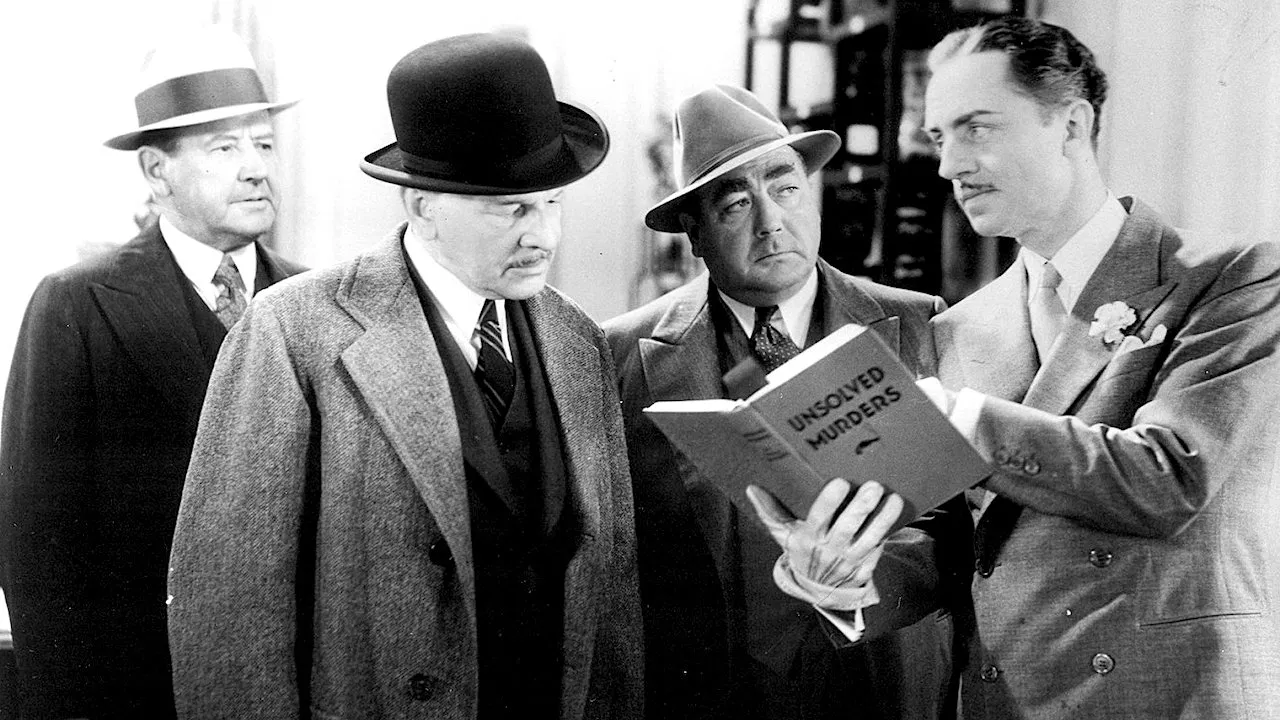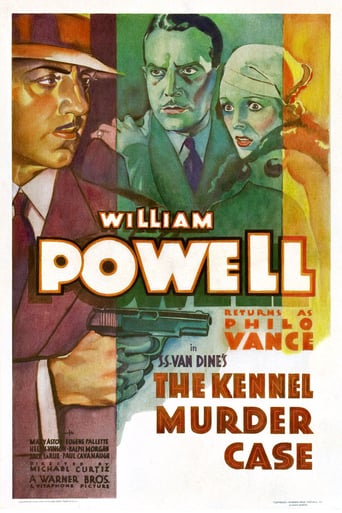

This is the sixth Philo Vance mystery film and the fifth and last starring William Powell, five films which he made between 1929 and 1933. (In 1930 a single Philo Vance film intervened which starred Basil Rathbone, THE BISHOP MURDER CASE, see my review). After this, Philo Vance was played by eight different actors until 1947, when the series ended (it had gone into abeyance during the War, between 1940 and 1947). Here William Powell continues to become more and more recognisable as the William Powell we all admire from his later films. Although the script gives him little opportunity, he still manages to make the occasional comment with the typical Powellesque mixture of nonchalance and challenge. Insouciance is never that far away, and one can sense it trembling on his lips. His sense of humour peeks through the workmanlike script from time to time, like a mouse glancing through its hole at a cheese on the table but not daring to try to approach it. (A whole cheese of the old-fashioned kind bears a certain resemblance to a director's cut, doesn't it? It is more nearly what its Maker intended.) This film has many characters, including seven murder suspects. The plot is convoluted, there is more than one murder, and there may even be more than one murderer. A central feature of the complex plot is that old chestnut, the murder in a locked room which is bolted from the inside. In this film, unlike others one could mention, we see a detailed and closeup view of just how that trick is done. I am not aware of when the famous motif of a murder in a sealed and bolted room first entered detective fiction, and doubtless experts in the genre might have some idea. But here we have it on screen in 1933, and trackers of ingenious plot twists can add that as one of the early dots which they join in their graph. But there are many red herrings and other complications in this tale. There may be not one, not two, but three murder weapons, for instance. Which one did the deed? Why are there so many? The sub-plot of a Chinese cook who is really a Columbia University graduate specializing in the acquiring of rare porcelain adds a further twist. Certainly this story was very meticulously plotted, with as many intersecting possibilities as a well-cut jewel has facets. It gleams from all angles, and the answers may come from more than a single one. Detective story lovers will not be disappointed. Mary Astor is one of the two female stars, but has little to do other than walk through her lines. This is a plot film, not a character film, and nothing matters but whodunit, or whodunn'em. There are no wisecracks or smart dialogue in this film, but it does have a running humorous sub-plot of the coroner whose meals keep being interrupted as he is repeatedly summoned to check on more bodies, and he gets grumpier and grumpier. He is very funny, and this lightens the film up a little. The film never rises above the mediocre except in its plot elements. Oh yes, there are cute dogs in this film. In most films, we get cute girls, but in this one we get cute dogs.
... View MoreI decided to invest 73 minutes of my to life to THE KENNEL MURDER CASE for one reason only and that is it's directed by the great Michael Curtiz who if he's not considered the greatest film director of the 20th Century is certainly the greatest director of the classic period of Hollywood . If you have no idea of of who he is please take the time and trouble of looking at his body of work . He has directed some of the greatest films of all time . After you've done that you could perhaps watch THE KENNEL MURDER CASE which I think proves the point that not even the most gifted director can a good movie unless they're given a good script The problem with the screenplay starts even before the runtime . The title fools the audience in to thinking they're going to be watching a story set at a kennel club and indeed the opening location takes place there where a prize winning dog is found dead but this has got nothing to do with the main plot involving a suspected suicide that turns out is a murder The screenplay is confused , inconsistent and just plain bizarre . We're introduced to Philo Vance a sort of detective who's obviously based on Sherlock Holmes and watching William Powell as Vance you're instantly reminded of Bail Rathbone in his famous role as Holmes . Archer Cole is found with a bullet wound to his head in a locked room so it's an obvious suicide . Obvious to everyone except Vance who states " Suicide is a psychological impossibility to Coe " How he arrives to this conclusion is unclear . Maybe Jack Nicholson didn't warn him ? Vance shows himself to be lacking in perceptive skills when it's revealed by a doctor who has just had his breakfast or lunch interrupted ( It's never made clear and the film contains these gaps in continuity ) Coe has not only shot himself but he was bludgeoned and stabbed as well . So think about it - someone is whacked over the head and has been stabbed and this great detective called Philo Vance didn't notice this ? I have a theory that people who enjoy whodunnits are slightly less intelligent than the mainstream population but delude themselves that they're much cleverer than the vast majority of the population . If they're able to work out who the murderer is before the detective that some how makes them a shining intellectual on a par with Albert Einstien or Stephen Hawking but we the audience are supposed to swallow totally implausible things such as Coe receiving a fatal stab wound to the back and not realising that he's been stabbed in the first place . It really is a ridiculous piece of storytelling and despite it being one of the director's lesser works Curtiz does at least inject a pace and rhythm to the movie making it far less stagy than it could have been
... View More***SPOILERS*** Overly plotted, down to the very last pottery fragment, murder mystery that has the great detective Philo Vance, William Powell,completely befuddled until the last five or so minutes in the film. It's then that Philo puts all the pieces together and ends up getting his man with the help of a very determined Doberman Pincher.The murder victim Chinese antique collector Archer Coe, Robert Barrat, was at first made to look like he in fact killed himself by blowing his brains out with his own, registered in his name, handgun. It's when coroner Dr. Doremous, Etienne Girardot, examined Coe's corpse that he realized that he was in fact already dead before he-a total impossibility-shot himself! The only possible suspect in Coe's murder is his brother, who has no use for him at all, Brisbane, Frank Conroy, who has an air-tight alibi in him being on a train to Chicago at the time of Coe's murder. That soon falls apart when Brisbane himself is found dead-murdered-in a closet in Coe's mansion.Philo has his work out out for him in the fact that he's greatly hampered by almost everyone involved with the late Archer Coe wanting to murder him if, and that's a big "If", only they had the chance! The chance did come when one of Coe's many many enemies found him alone in his mansion but, being the armature that he is, screwed it all up! Not only did he bumble Coe's murder he ended up murdering Coe's brother Brisbane-whom he mistook for Coe- who was the person, by not realizing that he was already dead, who put the bullet in Coe's brain! To make the already confusing movie even more confusing we also have Coe's Chinese cook Liang, James Lee, threaten Coe, when he was still alive, for him selling off his collection of expensive Chinese porcelain's that he, Liang, illegally bought for him on the black market.Of all the reasons to murder Coe the most obvious was overlooked by Philo, as well as the police, because they convinced themselves that his killer, in how he accidentally stymied them, had to have the brains of a master criminal to do it! It was in the end that Philo finally came to the conclusion to who murdered Archer Coe but only by getting all the suspects, as much as a half dozen of them, in Coe's murder in the same room and then have a police dog-a Doberman Pincher-sniff him out!
... View MoreEnjoyed viewing this film on TCM and watching a very young William Powell, (Philo Vance) playing detective just like he did with Myrna Loy in the "Thin Man Series". Back in the 1930's William Powell played in the Philo Vance Series and in this picture, the famous veteran actress Mary Astor, (Hilda Lake) becomes one of the suspects in a murder/suicide case where a man named, Archer Coe, (Robert Barrot) is found dead and Archer was in a room that was bolted from the inside. Ralph Morgan, (Raymond Wrede/Archer's Secretary) gave a great supporting role and was the brother to Frank Morgan who appeared "In the Wizard of Oz" 1939. Eugene Palette, (Detective Sgt. Heath) appeared in quite a few of these Philo Vance films and also gave a great performance in "Robin Hood" with Errol Flynn. Always remember, the least likely actor could very well be the killer. Enjoy a great Classic from the past.
... View More